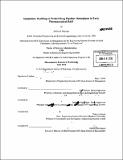Simulation modeling to predict drug pipeline throughput in early pharmaceutical R&D
Author(s)
Heyman, Jeffrey B. (Jeffrey Brian)
DownloadFull printable version (15.39Mb)
Other Contributors
Leaders for Global Operations Program.
Advisor
Roy Welsch and Deborah Nightingale.
Terms of use
Metadata
Show full item recordAbstract
With high costs and growing concern about research and development (R&D) productivity, the pharmaceutical industry is under pressure to efficiently allocate R&D funds. Nonetheless, pharmaceutical R&D involves considerable uncertainty, including high project attrition, high project-to-project variability in required time and resources, and long time for a project to progress from a biological concept to commercial drug. Despite this uncertainty, senior leaders must make decisions today about R&D portfolio size and balance, the impact of which will not be observable for many years. This thesis investigates the effectiveness of simulation modeling to add clarity in this uncertain environment. Specifically, performing research at Novartis Institutes for Biomedical Research, we aim to design a process for developing a portfolio forecasting model, develop the model itself, and evaluate its utility in aiding R&D portfolio decision-making. The model will serve as a tool to bridge strategy and execution by anticipating whether future goals for drug pipeline throughput are likely to be achievable given the current project portfolio, or whether adjustments to the portfolio are warranted. The modeling process has successfully delivered a pipeline model that outputs probabilistic forecasts of key portfolio metrics, including portfolio size, positive clinical readouts, and research phase transitions. The model utilizes historical data to construct probability distributions to stochastically represent key input parameters, and Monte Carlo simulation to capture the uncertainty of these parameters in pipeline forecasts. Model validation shows good accuracy for aggregate metrics, and preliminary user feedback suggests strong initial buy-in within the organization.
Description
Thesis (M.B.A.)--Massachusetts Institute of Technology, Sloan School of Management; and, (S.M.)--Massachusetts Institute of Technology, Engineering Systems Division; in conjunction with the Leaders for Global Operations Program at MIT, 2010. Cataloged from PDF version of thesis. Includes bibliographical references (p. 72-73).
Date issued
2010Department
Leaders for Global Operations Program at MIT; Massachusetts Institute of Technology. Engineering Systems Division; Sloan School of ManagementPublisher
Massachusetts Institute of Technology
Keywords
Sloan School of Management., Engineering Systems Division., Leaders for Global Operations Program.